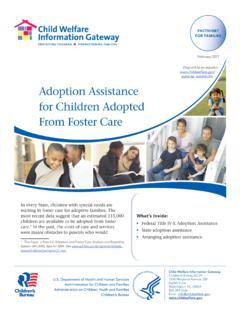Transcription of The California Wellness Foundation
1 A project funded byThe California Wellness FoundationE X PANDING TRANSITIONAL SERVICES FOR EMANCIPATED FOSTER youth :AN INVESTMENT IN California S TOMORROWCHILDREN S ADVO C ACY INSTITUTEUNIVERSITYOFSANDIEGOSCHOOLOFLAW CO N T R I B U TO R S :MELANIE DELGADOROBERT R. PACKARD KAREN PROSEKELISA WEICHEL JANUARY 2007 CAI COUNCIL FOR CHILDRENGary Redenbacher, ChairGary Richwald, MD, MPH, Vice-ChairRobert L. Black, MDJohn Goldenring, MD, MPHL ouise Horvitz, MSW, PsyDHon. Leon S. KaplanJames McKennaThomas A. PapageorgeBlair Sadler, JDGloria SamsonAlan Shumacher, MDOwen Smith EXECUTIVE DIRECTO RRobert FellmethPrice Professor ofPublic Interest Law5998 Alcal Park San Diego, California 92110 Phone: (619) 260-4806 Fax: (619) THE RESEARCHThis report was prepared by the University of San Diego School of Law s Children sAdvocacy Institute (CAI) staff and law in 1989, CAI s mission is to improve the health, safety, and well-being of children.
2 CAI advocates in the legislature to makelaws, in the courts to interpret laws, before administrative agencies to implement laws, and before the public to educate and build sup-port for laws to improve the status of children. In addition to its advocacy program, CAI operates an academic program, providing acombination of classroom instruction and clinical training in child advocacy to USD law students. CAI s academic program is fund-ed by the USD School of Law, and its advocacy program is funded by external grants, contracts, and authors would like to thank the following people for their work on this project: Christina Riehl (CAI StaffAttorney); Ed Howard(CAI Senior Policy Advocate); Kriste Draper (Equal Justice Works Fellow); Alicia Sanchez (former CAI Senior Policy Advocate);Tabare Depaep and Ilia Lopez (research consultants); Erin Davis, Catherine Learned, Emily Reinig, Mittal Shah, and Summer Stech(USD law students); Annemarie D Angelo, Meredith D Angelo, and Nanette Herbuveaux (editorial consultants); and Kathy Self,Marissa Martinez, and Lillian Clark (CAI Executive Assistants).
3 CAI would like to thank and acknowledge the young adults and agency staff from across the state who participated in this project. CHILDREN S ADVOCACY INSTITUTEU N I V E R S I TY OF SAN DIEGO SCHOOL OF LAWThis project is funded by a grant to the Children sAdvocacy Institute from The California Wellness Foundation (TCWF).Created in 1992 as an independent,private Foundation ,TCWF s mission is to improve the health of the people of California by mak-ing grants for health promotion, Wellness education and disease prevention OF Executive Summary ..iI. Introduction ..1II. The Adult Child ..2 III. Federal Laws and Policies Impacting Former Foster youth ..4A. 1986 1998: Title VI-E Independent Living Initiative ..4B. 1999 Present: John H. Chafee Foster Care Independence Act ..4C. 2002 Present: Chafee Educational Training Vouchers ..4D. States Use ofFoster Care Independence Act Funds.
4 5E. Federal Policies Inhibiting Former Foster youth Self-Sufficiency ..6IV. California s Former Foster youth ..7A. Relevant California Statutes ..7 Relevant California Caselaw ..9V. Housing Issues Facing California Former Foster youth ..11A. California s Housing Crisis ..11B. Transitional Foster Care Housing Assistance ..11C. California s Under-funding ofTransitional Housing Programs ..13D. Model for Success: First Place Fund for youth ..14VI. Education Issues Facing California s Former Foster youth ..15A. Access to Tuition ..15B. Access to Monetary Support Beyond Tuition ..15C. Access to Health and Mental Health Services ..15D. Access to Mentors ..16E. California : Available Programs ..16F. California : Model for Success Guardian Scholars ..16G. Moving Forward: California s Assistance with Higher Education ..17 VII. Health Care Issues Facing California s Former Foster youth .
5 18 VIII. Independent Living Programs ..19IX. Expanding Transitional Services ..20A. States Offering Expanded Transitional Services ..201. Illinois ..202. Arizona ..213. Florida ..214. Connecticut ..22B. Expanded Transitional Services Program Models ..221. Contract Model ..232. Pure Extended Foster Care Model ..233. Modified Extended Foster Care Model ..234. CASA/Mentor Payee Model ..235. Transition Guardian Model ..23C. youth Observations ..251. Observations from Focus Group ..252. Survey Results ..26X. Transition Guardian Plan: Cost-Benefit Analysis ..30XI. Expanded Transitional Services: Funding Options ..32 XII. Recommendations and Lessons to Guide Reform ..33A. Key Recommendations for California ..33B. Lessons to Guide Advocates and Policymakers Seeking Reform ..34 Endnote ..37iAlthough foster care is intended to be a temporary arrangement as social services agencies assist families towardreunification or pursue other permanency options, such as adoption or legal guardianship over 4,000 youth ageout of California s foster care system each terms aged out or emancipated describe foster youth whoare discharged from the foster care system when they attain a certain , like almost all states, has statutes authorizing dependency courts to retain jurisdiction of foster youth beyondage 18.
6 Generally, however, jurisdiction is only retained for a specific purpose and only then for the minimum amountof time after time, the state which has assumed the role of parent in these cases turns her children outinto the street at age 18 with no place to live, no means of supporting themselves, no safety net, and no hope for their future. Current Outcomes for California s Foster ChildrenWhat happens to youth after they are forced out of California s foster care system? Not surprisingly, the majority of for-mer foster youth fail to achieve self-sufficiency. Studies of California s former foster youth found that: 65% emancipate without a place to live. Less than 3% go to college. 51% are unemployed. Emancipated females are 4 times more likely to receive public assistance than the general any given year, foster children comprise less than of the state s population, and yet 40% of persons living in home-less shelters are former foster children.
7 Asimilarly disproportionate percentage of the nation s prison population is com-prised of former foster youth . In any given year,foster children comprise less than of the state spopulation,and yet 40% of persons living in homeless shelters are former foster similarly disproportionate percentage of the nation s prison population is comprised of former foster Programs and Services are InadequateWhile some state and federal funding is available for independent living programs (ILP) and services for former fosteryouth, it is inadequate to properly provide the kind of support necessary to enable these youth to transition to self-suffi-ciency. In California , funding and services for this population vary county by county, with different eligibility policies,program administration, funding, and services. As a result, current programs for emancipating foster youth are fragment-ed and under-funded, fail to provide comprehensive assistance and services, and do not reach a significant number of for-mer foster youth in a meaningful some state and federal funding is available for independent living programs (ILP)and services for former foster youth ,it is inadequate to properly provide the kind ofsupport necessary to enable these youth to transition to studies have shown that the average young person must rely on parental support during the transitional period, anddoes not become self-sufficient until age 26.
8 Money is not the only way parents support their children during this period;iiEXPANDING TRANSITIONALSERVICES FOR EMANCIPATED youth parental support also continues in the form of free or subsidized housing, food, and medical care as well as the manyintangible ways that a family provides support to its children. Foster children do not have this safety studies have shown that the average young person must rely on parental supportduring the transitional period,and does not become self-sufficient until age California continues to neglect her emancipated foster youth population, their outcomes will continue to be bleak. But turn-ing these young adults out on the street at age 18 with minimal assistance does not just affect their futures; such a policy deci-sion has significant long-term implications for the state as well. From a financial perspective, significant costs resulting fromthe status quo system take the form of public assistance, homeless aid, health care for the indigent, loss of taxable income, andincarceration.
9 Other societal costs arguably more important but harder to quantify include the loss of potentially educatedand skilled members of the workforce, who could help keep California s workforce competitive with the rest of the States Efforts to Improve OutcomesFaced with similar circumstances, some states have implemented expanded transitional services, which involve programsand funding that go beyond traditional ILPservices. For example, Illinois, Arizona, Connecticut, and Florida have eachtaken meaningful steps toward improving the transitional experience for emancipated foster youth , providing them with ameaningful opportunity to pursue higher education and vocational training that enable them to become of the innovative programs offered by these states include the following: In Illinois, youth may remain wards of the court until age 21 provided they are involved in a postgraduate educationalor vocational training program.
10 In order to remain wards, the youth must petition the court. Extended foster care is theyouth s option, not the court s. If jurisdiction is retained, the court holds status hearings and the youth continues to havean assigned caseworker. However, the caseworker s involvement depends on the youth s needs. youth may remain instate-subsidized foster homes, transitional living programs, or on their own. Arizona s extended foster care differs from Illinois in that the court terminates jurisdiction. youth remain in care ona voluntary, contractual basis. In exchange for a $585 monthly stipend and services from the social service agency, theyouth must actively pursue education or vocational training. Under certain circumstances, youth who are employed butnot attending school or who are involved in therapy may also remain in care. Monthly stipends are sent directly to the par-ticipating youth .










